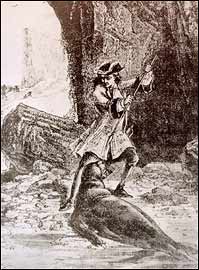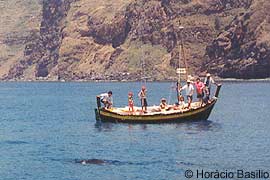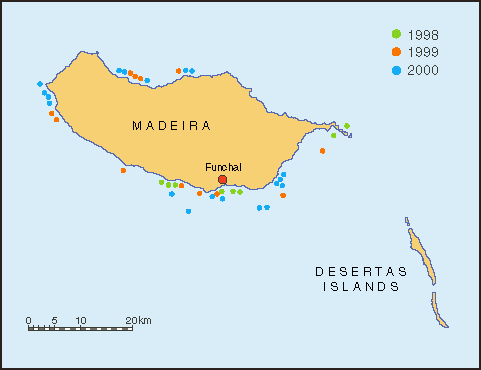|
When the first Portuguese explorers landed on Madeira in 1420, they found in a bay on the south of the island numerous strange sea creatures whose cry was likened to that of the wolf. Since then, the monk seals of Madeira have been known as “lobos-marinhos” – sea-wolves – and the bay as “Câmara de Lobos” – literally “Wolves’ Chamber”.
The chronicler of that time, João de Barros, described how monk seals were abundant there: “...so many there were that they covered the entire ground” (Machado 1979).
Historical accounts of the exploration of Madeira mention seals only at Câmara de Lobos, possibly suggesting that the species was not to be found elsewhere around the island, or that it was present on other coasts only in insignificant numbers.
The discovery of the seals ushered in an intense period of persecution, as illustrated in the reports of João de Barros. The hunting of the animals, he declares was “by no means a small pastime for the people, because they killed many of them, and they took great pleasure in the killing” (Machado 1979, Johnson & Lavigne 1999). A lucrative industry quickly developed in exploiting the animal for its hide and oil.

Fig. 1. “…they killed many of them, and they took great pleasure in the killing” (Machado 1979).
Curiously, some people were known to place a seal flipper under their pillow to encourage restful sleep, an island tradition that appears to have been rooted in ancient superstitions from the Greek and Roman world recorded by Pliny the Elder (Johnson & Lavigne 1999).
Increasingly endangered, the monk seals of Madeira continued to survive only in remote, inaccessible and uninhabited places, such as the Desertas Islands. By the mid-20th century, largely due to fishing pressures and human disturbance, seals were facing extinction here as well but their decline was eventually reversed following implementation of a recovery plan in 1988, which saw the establishment of the Desertas Islands Nature Reserve. From a surviving population of just 6-8 animals, monk seal numbers at the Desertas have since increased to an estimated 23 individuals (Pires & Neves 2000).
While the monk seal population on Madeira had been virtually eradicated by the beginning of the 20th century, records suggest that it was still possible to observe the animals occasionally around Ponta de São Lourenço, a wild and remote stretch of coast on the easternmost tip of the island, dominated by steep cliffs. Protected by this inaccessible coast, seals continued to cling to survival in small numbers. In 1978, an expedition to this area was even able to confirm the existence of a small colony, comprising 4 adults and 2 pups (Machado 1979).
Sporadically, seals were also sighted in other areas of Madeira. Locals can even recall observing one or two individuals swimming in the bay of Funchal (Madeira’s capital) 25 years ago, although such events became exceedingly rare.
Since 1998, however, sightings reports around Madeira have become more frequent. In that particular year, there were eight observations, two allowing identification of a known breeding female from the Desertas Islands. This information was considered particularly significant, allowing us to confirm for the first time that the range of the seals inhabiting the Desertas Islands also includes the main island of Madeira. 
Fig. 2. A monk seal under observation near Cabo Girão, south coast of Madeira, 14 June 1998
The following year, 1999, the recorded observations increased to 12; by 2000 they had risen to 19.
Observations mostly consisted of single individuals that remained visible only for a few minutes. In June 2000, however, two seals (probably a female and its juvenile offspring) were observed three times in the same area along the southwest coast.
Essentially, all animals were probably observed while transiting. In some cases, fishermen reported that the seals stayed close to them for prolonged periods in order to snatch the fish from their lines.
Analysing our collected data (see figure 3), it is possible to verify that sightings are increasing around Madeira island. Their occurrence shows a concentration tendency in places with human coastal activities such as diving, fishing and sailing, in other words, in the vicinity of potential observers. As such, we cannot exclude the possibility that monk seal presence may be even more significant in remoter areas largely devoid of human presence. 
Fig. 3. Monk seal sightings around Madeira, 1998-2000.
By the same token, we cannot ignore the potential impact that increasing public awareness of the seal’s ecological importance may have had in encouraging more frequent reporting of observations. If this is indeed the case, increased reports would not necessarily translate into increased monk seal sightings.
Other factors, however, appear to contradict this statistical phenomenon. Of the total sightings around Madeira, for example, only a few were reported by professional fishermen. A possible explanation for this is provided by our experience in field research which shows that some fishermen fail to report seal observations because they fear the creation of new marine reserves and new fishing restrictions.
In our view, the increased sightings around Madeira are likely to be at least partly attributable to the growing monk seal population on the Desertas Islands, encouraging enlargement of the population’s dispersion area. The fact that known individuals from the Desertas have been identified around the main island adds additional weight to this hypothesis.
While we believe that these increasing monk seal sightings are probably a result of both factors – increasing reports from informed observers and dispersing seals from an increasing population in the Desertas – both offer positive news for monk seal conservation in the Madeira archipelago.
Sources
Johnson, W.M., & D.M. Lavigne. 1999. Monk seals in antiquity. The Mediterranean monk seal (Monachus monachus) in ancient history and literature. The Netherlands Commission for International Nature Protection. Mededelingen 35: 1-101.
[Online abstract: www.monachus-guardian.org/mguard03/03scien1.htm].
Machado, M.A.J. 1979. Os Lobos Marinhos (genero Monachus, Fleming 1812). Contribuição para o seu conhecimento e protecção. Museu do Mar, Cascais: 1-249.
Pires, R. & Neves, H.C. 2000. Monachus Science. Monk seal sightings on open beaches in the Desertas Islands – Madeira archipelago. The Monachus Guardian 3(2): November 2000. |



